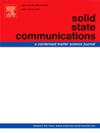Li基半heusler化合物LiYXZ (X = Pt, Pd;Z = Si, Ge)
IF 2.1
4区 物理与天体物理
Q3 PHYSICS, CONDENSED MATTER
引用次数: 0
摘要
在本文中,我们研究了两个季系Heusler化合物LiYXZ (X = Pt, Pd;Z = Si, Ge),拥有18个价电子。两种化合物的电子能带图显示了它们的半导体性质,LiYPtSi和LiYPdGe分别存在1.038 eV和0.443 eV的间接禁能隙。本文采用FP-LAPW方法和半经典玻尔兹曼输运理论,利用第一性原理计算对材料的结构稳定性、力学、电子、光学和输运性质进行了研究。用Perdew Burke - Ernzerhof格式(GGA-PBE)和Trans-Blaha修正的Becke-Johnson交换势(mBJ)的广义梯度近似处理交换相关效应。在可见和红外能量范围内发现了重要的四元赫斯勒光谱响应。LiYPtSi和LiYPdGe的熔点分别为1353.59±300 K和1435.20±300 K;因此,在1200 K的温度范围内计算了所有的基本热电性能以及性能曲线(zT)。所研究的材料是纯各向异性的,具有延性,动态和机械稳定。在热电性能方面,LiYPtSi在300 K时的塞贝克系数为241 μV/K,晶格热导率为1.34 × 1015W/mK, LiYPdGe的晶格热导率为238 μV/K, 1.00 × 1015W/mK。在300 K时,zT分别为0.06和0.068,这保证了材料在室温范围内不是高效热电元件,而是在高温下。本文章由计算机程序翻译,如有差异,请以英文原文为准。
A comprehensive DFT study on the physical attributes of Li based Half-Heusler compounds LiYXZ (X = Pt, Pd; Z = Si, Ge)
In the present article, we have explored two quaternary Heusler compounds LiYXZ (X = Pt, Pd; Z = Si, Ge) possessing 18-valence electrons. The electronic band plots of both compounds reveal the semiconducting nature of them depicting the presence of an indirect forbidden energy gap of 1.038 eV for LiYPtSi and 0.443 eV for LiYPdGe respectively. This report presented the structural stability, mechanical, electronic, optical and transport properties were investigated by the FP-LAPW method and semiclassical Boltzmann transport theory using first-principles calculations for the practical utilization of the materials. Exchange-correlation effect is treated with the generalized gradient approximation with Perdew Burke Ernzerhof scheme (GGA-PBE) and Trans-Blaha modified Becke-Johnson (mBJ) exchange potential. Important optical responses of studied quaternary Heuslers are found in the visible and infrared energy range. The melting point of LiYPtSi and LiYPdGe are calculated as 1353.59 ± 300 K and 1435.20 ± 300 K respectively; owing to this fact all the prime thermoelectric properties along with the Figure of Merit (zT) are calculated in the temperature range of 1200 K. The investigated materials are purely anisotropic with ductile property, dynamically and mechanically stable. In an overview of thermoelectric properties, the Seebeck coefficient and the lattice thermal conductivity at 300 K for LiYPtSi are 241 μV/K, 1.34 × 1015 W/mK and for LiYPdGe are 238 μV/K, 1.00 × 1015W/mK respectively. The respective value of zT was 0.06 and 0.068 at the 300 K that ensures the materials is not to be efficient thermoelectric elements in the room-temperature range but at high temperature.
求助全文
通过发布文献求助,成功后即可免费获取论文全文。
去求助
来源期刊

Solid State Communications
物理-物理:凝聚态物理
CiteScore
3.40
自引率
4.80%
发文量
287
审稿时长
51 days
期刊介绍:
Solid State Communications is an international medium for the publication of short communications and original research articles on significant developments in condensed matter science, giving scientists immediate access to important, recently completed work. The journal publishes original experimental and theoretical research on the physical and chemical properties of solids and other condensed systems and also on their preparation. The submission of manuscripts reporting research on the basic physics of materials science and devices, as well as of state-of-the-art microstructures and nanostructures, is encouraged.
A coherent quantitative treatment emphasizing new physics is expected rather than a simple accumulation of experimental data. Consistent with these aims, the short communications should be kept concise and short, usually not longer than six printed pages. The number of figures and tables should also be kept to a minimum. Solid State Communications now also welcomes original research articles without length restrictions.
The Fast-Track section of Solid State Communications is the venue for very rapid publication of short communications on significant developments in condensed matter science. The goal is to offer the broad condensed matter community quick and immediate access to publish recently completed papers in research areas that are rapidly evolving and in which there are developments with great potential impact.
 求助内容:
求助内容: 应助结果提醒方式:
应助结果提醒方式:


